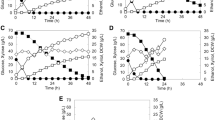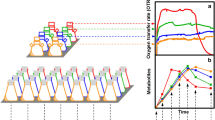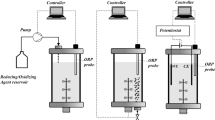Abstract
Objective
A correlation among different volumetric oxygen transfer coefficients (kLa) and the oxireduction potential (ORP) in batch fermentations using Scheffersomyces stipitis was evaluated. Experiments were performed using a mixture of xylose and glucose as the substrates.
Results
Microaerophilic condition (kLa = 4.9 h−1) have shown to be suitable when compared to complete anaerobiosis (kLa = 0), providing an ethanol yield and a productivity after 48 h of 64.3% and 0.45 g ethanol L−1 h−1, respectively; the maximum ethanol titer obtained was 21.50 g ethanol L−1. Values of ORP varying from − 270 to − 330 mV resulted in high ethanol production from xylose by S. stipitis.
Conclusions
Different ORP values were found in anaerobiosis and kLa 4.9 h−1, suggesting that for ethanol production by S. stipitis, values from − 270 to − 330 mV are favorable under the studied circumstances. In this ORP range, the greatest rates of xylose consumption and ethanol production were registered. ORP monitoring was demonstrated to be a suitable option for online control throughout the fermentation processes, which may provide a more efficient bioprocess operation with a very low O2 concentration.




Similar content being viewed by others
References
Bellido C, González-Benito G, Coca M, Lucas S, García-Cubero MT (2013) Influence of aeration on bioethanol production from ozonized wheat straw hydrolysates using Pichia stipitis. Bioresour Technol 133:51–58
de Sales BB, Scheid B, Gonçalves DL, Knychala MM, Matsushika A, Bon EPS, Stambuk BU (2015) Cloning novel sugar transporters from Scheffersomyces (Pichia) stipitis allowing D-xylose fermentation by recombinant Saccharomyces cerevisiae. Biotechnol Lett 37:1973–1982
du Preez JC (1994) Process parameters and environmental factors affecting d-Xylose fermentation by yeasts. Enzyme Microb Technol 16:944–956
du Preez JC, van Driessel B, Prior BA (1988) The relation between Redox potential and D-xylose fermentation by Candida shehatae and Pichia sitipitis. Biotechnol Lett 10:901–906
Farwick A, Bruder S, Schadeweg V, Oreb M, Boles E (2014) Engineering of yeast hexose transporters to transport D-xylose without inhibition by D-glucose. Proc Natl Acad Sci USA 111(14):2159–5164
Fernández-Sandoval MT, Galíndez-Mayer J, Moss-Acosta CL, Gosset G, Martinez A (2017) Volumetric oxygen transfer coefficient as a means of improving volumetric etanol productivity and a criterion for scaling up ethanol production with Escherichia coli. J Chem Technol Biotechnol 92:981–989
Gupta A, Verma JP (2015) Sustainable bio-ethanol production from agro-residues: a review. Renew Sustain Energy Rev 41:550–567
Jeffries TW, Van Vleet JRH (2009) Pichia stipitis genomics, transcriptomics, and gene clusters. FEMS Yeast Res 9:793–807
Jeffries TW, Grigoriev IV, Grimwood J, Laplaza JM, Aerts A, Asaf Salamov, Schmutz J, Lindquist E, Dehal P, Shapiro H, Jin YS, Passoth V, Richardson PM (2007) Genome sequence of the lignocellulose-bioconverting and xylose-fermenting yeast Pichia stipitis. Nat Biotechnol 25(3):319–326
Lin YH, Chien WS, Duan KJ (2010) Correlations between reduction–oxidation potential profiles and growth patterns of Saccharomyces cerevisiae during very-high-gravity fermentation. Process Biochem 45:765–770
Liu CG, Lin YH, Bai FW (2013a) Global gene expression analysis of Saccharomyces cerevisiae grown under redox potential-controlled very-high-gravity conditions. Biotechnol J 8:7332–7340
Liu CG, Xue C, Lin YH, Bai FW (2013b) Redox potential control and applications in microaerobic and anaerobic fermentations. Biotechnol Adv 31:257–265
Liu CG, Liu LY, Lin YH, Bai FW (2015) Kinetic modeling for redox potential-controlled repeated batch ethanol fermentation using flocculating yeast. Process Biochem 50:1–7
Liu CG, Qin JC, Lin YH (2017). Fermentation and Redox Potential, Fermentation Processes, Dr. Angela Jozala (Ed.), InTech. https://doi.org/10.5772/64640. https://www.intechopen.com/books/fermentation-processes/fermentation-and-redox-potential
Santos SC, Dionísio SR, de Andrade ALD, Roque LR, da Costa AC, Ienczak JL (2015) Fermentation of xylose and glucose mixture in intensified reactors by Scheffersomyces stipitis to produce ethanol. Int J Biol Biomol Agric Food Biotechnol Eng 9:482–487
Santos SC, de Sousa AS, Dionísio SR, Tramontina R, Ruller R, Squina FM, Vaz Rossell CE, da Costa AC, Ienczak JL (2016) Bioethanol production by recycled Scheffersomyces stipitis in sequential batch fermentations with high cell density using xylose and glucose Mixture. Bioresour Technol 219:319–329
Silva JPA, Mussatto SI, Roberto IC, Teixeira JA (2012) Fermentation medium and oxygen transfer conditions that maximize the xylose conversion to ethanol by Pichia stipis. Renew Energy 37:259–265
Silva DDV, Dussán KJ, Hernández V, da Silva SS, Cardona CA, Felipe MGA (2016) Effect of volumetric oxygen transfer coefficient (kLa) on ethanol production performance by Scheffersomyces stipitis on hemicellulosic sugarcane bagasse hydrolysate. Biochem Eng J 112:249–257
Skoog K, Jeppsson H, Hahn-Hägerdal B (1992) The effect of oxygenation on glucose fermentation with Pichia stipitis. Appl Biochem and Biotechnol 34(35):369–375
Stanbury PF, Whitaker A, Hall SJ (1995) Principles of fermentation technology. Butterworth-Heinemann, London
Su Y-K, Willis LB, Jeffries TW (2015) Effects of aeration on growth, ethanol and polyol accumulation by Spathaspora passalidarum NRRL Y-27907 and Scheffersomyces stipitis NRRL Y-7124. Biotechnol Bioeng 112:457–469
Thani A, Lin Y-H, Laopaiboon P, Laopaiboon L (2016) Variation of fermentation redox potential during cell-recycling continuous ethanol operation. J Biotechnol 239:68–75
Wise WS (1951) The measurement of the aeration of culture media. J Gen Microbiol 5:167–177
Acknowledgements
The authors acknowledge the Brazilian Bioethanol Science and Technology Laboratory - CTBE/CNPEM. This study was funded by FAPESP (Grant Numbers 2016/06142-0 and 2017/049970).
Author information
Authors and Affiliations
Corresponding author
Additional information
Publisher's Note
Springer Nature remains neutral with regard to jurisdictional claims in published maps and institutional affiliations.
Rights and permissions
About this article
Cite this article
Bonan, C.I.D.G., Biazi, L.E., Santos, S.C. et al. Online monitoring of the redox potential in microaerobic and anaerobic Scheffersomyces stipitis fermentations. Biotechnol Lett 41, 753–761 (2019). https://doi.org/10.1007/s10529-019-02674-6
Received:
Accepted:
Published:
Issue Date:
DOI: https://doi.org/10.1007/s10529-019-02674-6




